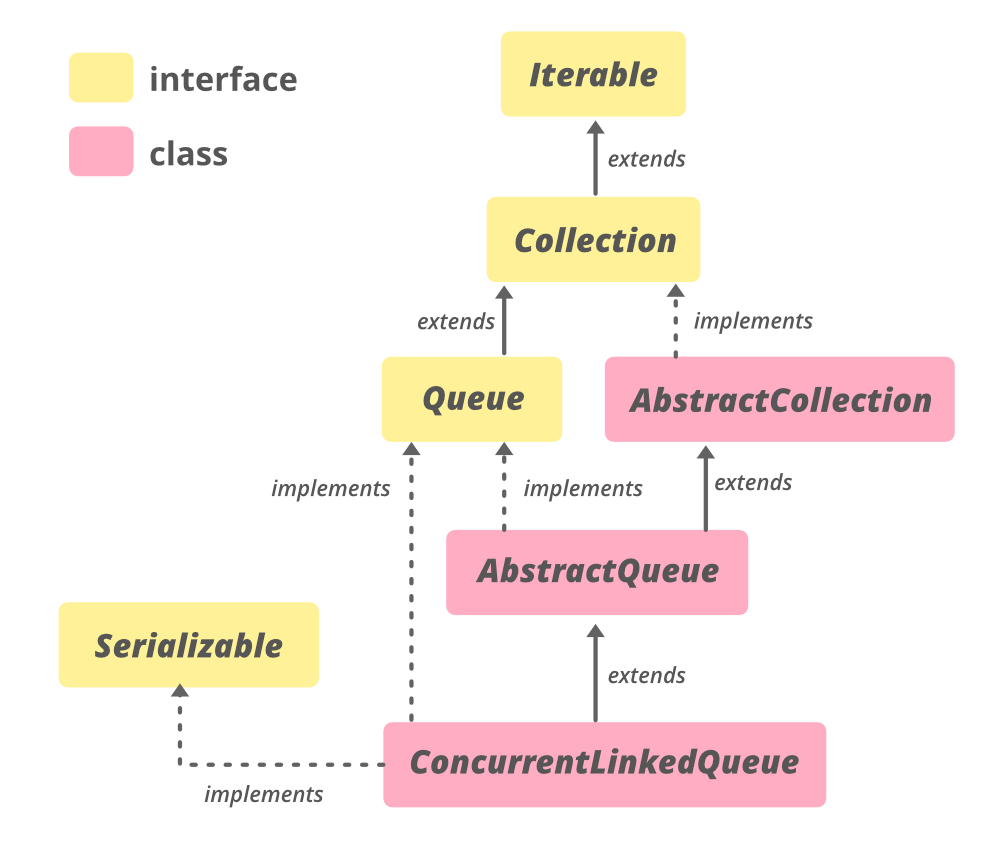Java ConcurrentLinkedQueue与实例
Java中的 ConcurrentLinkedQueue 类是Java Collection Framework的一部分。它属于 java.util.concurrent 包。它是在JDK 1.5中引入的。它被用来在LinkedList的帮助下并发地实现队列。它是一个 无界线程安全的 队列实现,以FIFO(先进先出)的方式在队列的尾部插入元素。当一个无界的队列被许多线程共享时,可以使用它。该类不允许出现空元素。迭代器是弱一致性的。该类及其迭代器实现了 Queue 和 Iterator 接口的所有可选方法。
类层次结构 。
java.lang.Object
↳ java.util.AbstractCollection<E>
↳ java.util.AbstractQueue<E>
↳ Class ConcurrentLinkedQueue<E>

声明
public class ConcurrentLinkedQueue<E> extends AbstractCollection<E> implements Queue<E>, Serializable
这里, E 是这个集合所维护的元素的类型。
ConcurrentLinkedQueue的构造函数
为了构造一个ConcurrentLinkedQueue,我们需要从 java.util.ConcurrentLinkedQueue 中导入它 。
1.ConcurrentLinkedQueue() : 这个构造函数用来构造一个空队列。
ConcurrentLinkedQueue<E> clq = new ConcurrentLinkedQueue<E>()
**2.ConcurrentLinkedQueue(Collection
ConcurrentLinkedQueue<E> clq = new ConcurrentLinkedQueue<E>(Collection<E> c)
下面是一个示例程序,说明Java中的ConcurrentLinkedQueue。
例1:
// Java program to demonstrate ConcurrentLinkedQueue
import java.util.concurrent.*;
class ConcurrentLinkedQueueDemo {
public static void main(String[] args)
{
// Create a ConcurrentLinkedQueue
// using ConcurrentLinkedQueue() constructor
ConcurrentLinkedQueue<Integer>
clq = new ConcurrentLinkedQueue<Integer>();
clq.add(12);
clq.add(70);
clq.add(1009);
clq.add(475);
// Displaying the existing LinkedQueue
System.out.println("ConcurrentLinkedQueue: "
+ clq);
// Create a ConcurrentLinkedQueue
// using ConcurrentLinkedQueue(Collection c)
// constructor
ConcurrentLinkedQueue<Integer>
clq1 = new ConcurrentLinkedQueue<Integer>(clq);
// Displaying the existing LinkedQueue
System.out.println("ConcurrentLinkedQueue1: "
+ clq1);
}
}
输出
ConcurrentLinkedQueue: [12, 70, 1009, 475]
ConcurrentLinkedQueue1: [12, 70, 1009, 475]
例2:
// Java code to illustrate
// methods of ConcurrentLinkedQueue
import java.util.concurrent.*;
class ConcurrentLinkedQueueDemo {
public static void main(String[] args)
{
// Create a ConcurrentLinkedQueue
// using ConcurrentLinkedQueue()
// constructor
ConcurrentLinkedQueue<Integer>
clq = new ConcurrentLinkedQueue<Integer>();
clq.add(12);
clq.add(70);
clq.add(1009);
clq.add(475);
// Displaying the existing ConcurrentLinkedQueue
System.out.println("ConcurrentLinkedQueue: "
+ clq);
// Displaying the first element
// using peek() method
System.out.println("First Element is: "
+ clq.peek());
// Remove and display the first element
// using poll() method
System.out.println("Head Element is: "
+ clq.poll());
// Displaying the existing ConcurrentLinkedQueue
System.out.println("ConcurrentLinkedQueue: "
+ clq);
// Get the size using size() method
System.out.println("Size: "
+ clq.size());
}
}
输出
ConcurrentLinkedQueue: [12, 70, 1009, 475]
First Element is: 12
Head Element is: 12
ConcurrentLinkedQueue: [70, 1009, 475]
Size: 3
基本操作
1.添加元素
为了添加元素,ConcurrentLinkedQueue提供了两个方法。
- add() 它插入元素,作为参数传递到这个并发连接队列的尾部。如果插入成功,该方法返回True。ConcurrentLinkedQueue是无界的,所以这个方法不会抛出IllegalStateException或返回false。
- addAll() 它插入集合的所有元素,作为参数传递到ConcurrentLinkedQueue的末端。插入元素的顺序与集合的迭代器返回的顺序相同。
// Java Program Demonstrate adding
// elements to ConcurrentLinkedQueue
import java.util.concurrent.*;
import java.util.*;
public class AddingElementsExample {
public static void main(String[] args)
{
// Create an instance of ConcurrentLinkedQueue
ConcurrentLinkedQueue<String> queue = new ConcurrentLinkedQueue<String>();
// Add String to queue using add method
queue.add("Kolkata");
queue.add("Patna");
queue.add("Delhi");
queue.add("Jammu");
// Displaying the existing ConcurrentLinkedQueue
System.out.println("ConcurrentLinkedQueue: " + queue);
// create a ArrayList of Strings
ArrayList<String> arraylist = new ArrayList<String>();
// add String to ArrayList
arraylist.add("Sanjeet");
arraylist.add("Rabi");
arraylist.add("Debasis");
arraylist.add("Raunak");
arraylist.add("Mahesh");
// Displaying the existing Collection
System.out.println("Collection to be added: " + arraylist);
// apply addAll() method and passed
// the arraylist as parameter
boolean response = queue.addAll(arraylist);
// Displaying the existing ConcurrentLinkedQueue
System.out.println("Collection added: " + response);
// Displaying the existing ConcurrentLinkedQueue
System.out.println("ConcurrentLinkedQueue: " + queue);
}
}
输出
ConcurrentLinkedQueue: [Kolkata, Patna, Delhi, Jammu]
Collection to be added: [Sanjeet, Rabi, Debasis, Raunak, Mahesh]
Collection added: true
ConcurrentLinkedQueue: [Kolkata, Patna, Delhi, Jammu, Sanjeet, Rabi, Debasis, Raunak, Mahesh]
2.移除元素
ConcurrentLinkedQueue的remove(Object o)方法是用来移除指定元素的单个实例的,如果它是存在的。它删除了一个元素 e ,使得o.e equals(e)。如果这个ConcurrentLinkedQueue包含指定的元素,它将返回true,否则它将返回false。
// Java Program Demonstrate removing
// elements from ConcurrentLinkedQueue
import java.util.concurrent.*;
public class RemovingElementsExample {
public static void main(String[] args)
{
// Create an instance of ConcurrentLinkedQueue
ConcurrentLinkedQueue<Integer> queue = new ConcurrentLinkedQueue<Integer>();
// Add Numbers to queue using add(e) method
queue.add(4353);
queue.add(7824);
queue.add(78249);
queue.add(8724);
// Displaying the existing ConcurrentLinkedQueue
System.out.println("ConcurrentLinkedQueue: " + queue);
// apply remove() for Number 78249
boolean response = queue.remove(78249);
// print results
System.out.println("Removing Number 78249 successful: " + response);
// Displaying the existing ConcurrentLinkedQueue
System.out.println("Updated ConcurrentLinkedQueue: " + queue);
}
}
输出
ConcurrentLinkedQueue: [4353, 7824, 78249, 8724]
Removing Number 78249 successful: true
Updated ConcurrentLinkedQueue: [4353, 7824, 8724]
3.迭代元素
ConcurrentLinkedQueue的iterator()方法用来返回一个与该ConcurrentLinkedQueue相同的元素的迭代器,其顺序是正确的。该方法返回的元素按照从头(head)到尾(tail)的顺序。返回的迭代器是弱一致性的。
// Java Program Demonstrate Iterating
// over ConcurrentLinkedQueue
import java.util.concurrent.*;
import java.util.*;
public class TraversingExample {
public static void main(String[] args)
{
// Create an instance of ConcurrentLinkedQueue
ConcurrentLinkedQueue<String> queue = new ConcurrentLinkedQueue<String>();
// Add String to queue using add(e) method
queue.add("Aman");
queue.add("Amar");
queue.add("Sanjeet");
queue.add("Rabi");
// Displaying the existing ConcurrentLinkedQueue
System.out.println("ConcurrentLinkedQueue : " + queue);
// Call iterator() method
Iterator iterator = queue.iterator();
// Print elements of iterator
System.out.println("\nThe String Values of iterator are:");
while (iterator.hasNext()) {
System.out.println(iterator.next());
}
}
}
输出
ConcurrentLinkedQueue : [Aman, Amar, Sanjeet, Rabi]
The String Values of iterator are:
Aman
Amar
Sanjeet
Rabi
4.访问元素
Queue 提供的 peek() 和 element() 方法用于访问 ConcurrentLinkedQueue 的元素。
element()方法与peek()方法的不同之处在于,如果这个队列是空的,它会抛出一个异常。
// Java Program Demonstrate accessing
// elements of ConcurrentLinkedQueue
import java.util.*;
import java.util.concurrent.*;
public class AccessingElementsExample {
public static void main(String[] args) throws IllegalStateException
{
// Create an instance of ConcurrentLinkedQueue
ConcurrentLinkedQueue<Integer> Q = new ConcurrentLinkedQueue<>();
// Add numbers to end of Queue
Q.add(7855642);
Q.add(35658786);
Q.add(5278367);
Q.add(74381793);
// print queue
System.out.println("Queue: " + Q);
// print head
System.out.println("Queue's head: " + Q.element());
// print head
System.out.println("Queue's head: " + Q.peek());
}
}
输出
Queue: [7855642, 35658786, 5278367, 74381793]
Queue's head: 7855642
Queue's head: 7855642
ConcurrentLinkedQueue的方法
| 方法 | 描述 |
|---|---|
| add(E e) | 在这个队列的尾部插入指定的元素。 |
| addAll(Collection c) | 按照指定集合的迭代器返回的顺序,将指定集合中的所有元素追加到这个队列的尾部。 包含(Object o) | 如果这个队列包含指定的元素,返回true。 forEach(Consumer action) | 对Iterable的每个元素执行给定的动作,直到所有的元素都被处理完,或者该动作抛出一个异常。 isEmpty() | 如果这个队列不包含任何元素,返回true。 iterator() | 以适当的顺序返回这个队列中的元素的迭代器。 offer(E e) | 在这个队列的尾部插入指定的元素。 remove(Object o) | 从这个队列中删除指定元素的一个实例,如果它存在的话。 removeAll(Collection c) |
删除这个集合中也包含在指定集合中的所有元素(可选操作)。 |
| removeIf(Predicate filter) | 删除此集合中满足给定谓词的所有元素。 retainAll(Collection c) |
只保留此集合中包含在指定集合中的元素(可选操作)。 |
| size() | 返回这个队列中元素的数量。 |
| spliterator() | 返回这个队列中的元素的Spliterator。 |
| toArray() | 返回一个包含该队列中所有元素的数组,并按适当的顺序排列。 |
| toArray(T[] a) | 返回一个包含该队列中所有元素的数组,并以适当的顺序排列;返回的数组的运行时类型是指定数组的类型。 |
java.util.AbstractQueue类中声明的方法
| 方法 | 描述 |
|---|---|
| 清除() | 移除队列中的所有元素。 |
| element() | 检索,但不删除这个队列的头部。 |
| remove() | 检索并删除此队列的头部。 |
java.util.AbstractCollection类中声明的方法
| 方法 | 描述 |
|---|---|
| containsAll(Collection c) | 如果这个集合包含指定集合中的所有元素,则返回true。 toString() | 返回这个集合的一个字符串表示。 ### java.util.Collection接口中声明的方法 方法 | 描述 |
如果这个集合包含了指定集合中的所有元素,返回true。 |
| equals(Object o) | 将指定的对象与这个集合进行比较,看是否相等。 |
| 哈希代码() | 返回此集合的哈希代码值。 |
| parallelStream() | 返回一个以该集合为源的可能的并行流。 |
| stream() | 返回一个以该集合为源的顺序流。 |
| toArray(IntFunction<T[]> generator) | 返回一个包含此集合中所有元素的数组,使用提供的生成器函数来分配返回的数组。 |
接口java.util.Queue中声明的方法
| 方法 | 描述 |
|---|---|
| 元素() | 检索,但不删除这个队列的头部。 |
| peek() | 检索但不删除这个队列的头部,如果这个队列是空的,则返回null。 |
| poll() | 检索并删除这个队列的头部,如果这个队列是空的,则返回null。 |
| remove() | 检索并删除此队列的头部。 |
参考资料 : https://docs.oracle.com/en/java/javase/11/docs/api/java.base/java/util/concurrent/ConcurrentLinkedQueue.html
 极客教程
极客教程